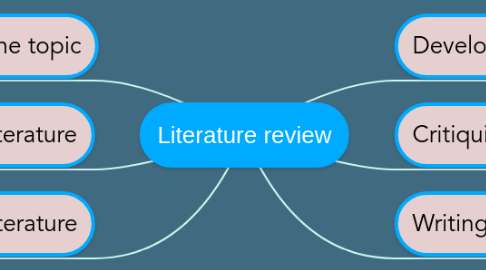
1. Selecting the topic
1.1. Purpose
1.1.1. to show gaps in the research
1.1.2. to justify your own research
1.1.3. to demonstrate your understanding of your field
1.1.4. to generate new research hypotheses
1.1.5. to place your own research in its context
1.1.6. to summarise and evaluate past research
1.1.7. to show similarities and differences (or consistencies and inconsistencies) in previous research
1.1.8. to give an overview of controversies in past research
1.1.9. Your literature review should be guided by a central research question. Remember, it is not a collection of loosely related studies in a field but instead represents background and research developments related to a specific research question, interpreted and analyzed by you in a synthesized way.
1.2. Scope
1.2.1. Broad, narrow?
2. Searching the literature
2.1. Reference manager
2.2. Google scholar
3. Surveying the literature
3.1. Guiding questions
3.1.1. What was the research question of the study you are reviewing? What were the authors trying to discover?
3.1.2. Was the research funded by a source that could influence the findings?
3.1.3. What were the research methodologies? Analyze its literature review, the samples and variables used, the results, and the conclusions. Does the research seem to be complete? Could it have been conducted more soundly? What further questions does it raise?
3.1.4. If there are conflicting studies, why do you think that is?
3.1.5. How are the authors viewed in the field? Has this study been cited?; if so, how has it been analyzed?
3.2. Galvan (2006) recommends building tables as a key way to help you overview, organize, and summarize your findings, and suggests that including one or more of the tables that you create may be helpful in your literature review. If you do include tables as part of your review each must be accompanied by an analysis that summarizes, interprets and synthesizes the literature that you have charted in the table. You can plan your table or do the entire summary chart of your literature using a concept map (such as using Inspiration)
3.3. You can create the table using the table feature within Microsoft Word, or can create it initially in Excel and then copy and paste/import the the Excel sheet into Word once you have completed the table in Excel. The advantage of using Excel is that it enables you to sort your findings according to a variety of factors (e.g. sort by date, and then by author; sort by methodology and then date)
3.4. Examples of tables that may be relevant to your review:
3.5. Definitions of key terms and concepts.
3.6. Research methods
3.7. Summary of research results
4. Developing arguments
4.1. Consider your purpose and voice before beginning to write. In the case of this Educ 7001 introductory literature review, your initial purpose is to provide an overview of the topic that is of interest to you, demonstrating your understanding of key works and concepts within your chosen area of focus. You are also developing skills in reviewing and writing, to provide a foundation on which you will build in subsequent courses within your M.Ed. and ultimately in your final project. In your final project your literature review should demonstrate your command of your field of study and/or establishing context for a study that you have done.
4.2. Consider how you reassemble your notes: plan how you will organize your findings into a unique analysis of the picture that you have captured in your notes. Important: A literature review is not series of annotations (like an annotated bibliography). Galvan (2006:72) captures the difference between an annotated bibliography and a literature review very well: "...in essence, like describing trees when you really should be describing a forest. In the case of a literature review, you are really creating a new forest, which you will build by using the trees you found in the literature you read."
4.3. Create a topic outline that traces your argument: first explain to the reader your line or argument (or thesis); then your narrative that follows should explain and justify your line of argument. You may find the program Inspiration useful in mapping out your argument (and once you have created this in a concept map form, Inspiration enables you to convert this to a text outline merely by clicking on the "outline" button). This can then be exported into a Microsoft Word document.
4.4. Reorganize your notes according to the path of your argument
4.5. Within each topic heading, note differences among studies.
4.6. Within each topic heading, look for obvious gaps or areas needing more research.
4.7. Plan to describe relevant theories.
4.8. Plan to discuss how individual studies relate to and advance theory
4.9. Plan to summarize periodically and, again near the end of the review
4.10. Plan to present conclusions and implications
4.11. Plan to suggest specific directions for future research near the end of the review
4.12. Flesh out your outline with details from your analysis
5. Critiquing the literature
5.1. Critical reading
5.1.1. interpret: understand the significance of data and clarify its meaning
5.1.2. analyse: break information down and recombine it in different ways
5.1.3. reason: develop a point of view through logical steps
5.1.4. evaluate: judge the worth, credibility or strength of the text
